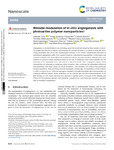Bimodal modulation of in vitro angiogenesis with photoactive polymer nanoparticles

Use este enlace para citar
http://hdl.handle.net/2183/38071
Excepto si se señala otra cosa, la licencia del ítem se describe como CC BY 4.0 https://creativecommons.org/licenses/by/4.0/
Colecciones
- Investigación (EPEF) [590]
Metadatos
Mostrar el registro completo del ítemTítulo
Bimodal modulation of in vitro angiogenesis with photoactive polymer nanoparticlesFecha
2023-11Cita bibliográfica
Tullii, G., Gutierrez-Fernandez, E., Ronchi, C., Bellacanzone, C., Bondi, L., Criado-Gonzalez, M., Lagonegro, P., Moccia, F., Cramer, T., Mecerreyes, D., Martín, J., & Antognazza, M. R. (2023). Bimodal modulation of in vitro angiogenesis with photoactive polymer nanoparticles. Nanoscale, 15(46), 18716-18726. https://doi.org/10.1039/D3NR02743K
Resumen
[Abstract]: Angiogenesis is a fundamental process in biology, given the pivotal role played by blood vessels in providing oxygen and nutrients to tissues, thus ensuring cell survival. Moreover, it is critical in many life-threatening pathologies, like cancer and cardiovascular diseases. In this context, conventional treatments of pathological angiogenesis suffer from several limitations, including low bioavailability, limited spatial and temporal resolution, lack of specificity and possible side effects. Recently, innovative strategies have been explored to overcome these drawbacks based on the use of exogenous nano-sized materials and the treatment of the endothelial tissue with optical or electrical stimuli. Here, conjugated polymer-based nanoparticles are proposed as exogenous photo-actuators, thus combining the advantages offered by nanotechnology with those typical of optical stimulation. Light excitation can achieve high spatial and temporal resolution, while permitting minimal invasiveness. Interestingly, the possibility to either enhance (≈+30%) or reduce (up to −65%) the angiogenic capability of model endothelial cells is demonstrated, by employing different polymer beads, depending on the material type and the presence/absence of the light stimulus. In vitro results reported here represent a valuable proof of principle of the reliability and efficacy of the proposed approach and should be considered as a promising step towards a paradigm shift in therapeutic angiogenesis.
Palabras clave
Vitro angiogenesis
Polymer nanoparticles
Polymer nanoparticles
Versión del editor
Derechos
CC BY 4.0 https://creativecommons.org/licenses/by/4.0/
ISSN
2040-3372
2040-3364
2040-3364






